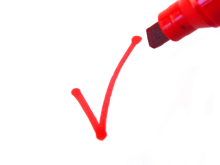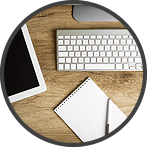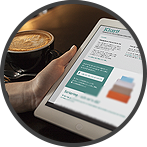A to-do list? Certainly, but in what format?
Datum: 2009-08-19 22:43

A central part of a well structured, personal work routine setup is a to-do list.
By that, I mean a list that you use over a long period of time, rather than write a new list every morning. A gathered list over all that you have to do, distinctly defined and with tasks that are adequate in size, gives you an easy and quick overview over what tasks you are responsible for.
That makes it possible for you to concentrate on your current task without meanwhile keeping several other tasks in your mind. Besides, it will give you a kick of satisfaction every time you will be able to check off something on your list.
But in what format should you keep the to-do list? Well, that is a matter of taste. Here are six suggestions:
-
The “Tasks”-function in Outlook
Our most common e‑mail applications all have convenient functions for handling to-do-lists. If a large part of your workday is spent by the computer this is an excellent alternative. It is easy to categorize the tasks by context, customer or project. It is also easy to sort them anyway you want to. You are able to add a due date and be reminded when you will have to start with the task.
If you have a smartphone you can synchronize it with your desktop (depending on your combination of phone and e‑mail application, though) and in that way you will be able to carry the list with you when you are out of the office.
Web service
If you are a fan of web based solutions (maybe you use Gmail for e‑mail) there are a number of web services to choose from. The one I am most impressed by at the moment is Todoist.com. There, you can keep your lists task by task in a very clean and minimalistic fashion, and check them off as you complete them one by one throughout the day.
One of the benefits of the web service is that your list is reachable wherever you are connected to the Internet. In addition to that, you can connect to your list through your phone if it is web enabled.Spreadsheet
Excel or any other spreadsheet application are great alternatives if you would prefer your list digital. Here also, it is easy to categorize, sort and choose to see only those tasks that are of interest at this particular moment.
Dedicated applications
Today, there are veritable heaps of applications whose sole purpose is to help you keep track of everything you do and make sure that you are making progress toward your long term goals. If you are a Mac user, I really recommend “Things” from Cultured Code that contains all the functions you need, and in a very aesthetic way.
Pen and paper (such as a notepad)
But, there are solutions not based in electronics and computers. Pen and paper still have some large benefits. They demand no time to start, there are no batteries that may run out and they will not break if you drop them.
Maybe you prefer your list on single sheets where every sheet represents a certain context in which you need to be to be able to complete the task. Then it is easy to design templates on your computer and print them out. Then, the A4-sheets can be equipped with lines and columns for deadlines, categorization by customer or project etcetera.
Would you rather prefer a notepad that you always bring to meetings, make sure you are strict about what you write in it. Is it for keeping your to-dos, fill it with to-do-tasks – page up and page down. Do not mix the tasks with random scribblings, phone numbers or thoughts that we usually use our notepads for. Why? Because, since you often every day need to decide what is the right task to do right now, you will be distracted if you have to browse through the notepad hunting for tasks hidden among other text.
Index cards
Last but not least there is the stack of index cards, sized as playing cards, made famous by Merlin Mann as “the Hipster PDA”. In my version, they are pre-printed with dedicated space for costumer- or project-categorization, the tasks in question and context. A document clip holds the cards together in a neat stack of, say ten-fifteen at a time.
They are easy to write tasks on, portable, easy to access and demand no time to start.
What is your favourite medium?
What is your best tip on how to organize task lists? Tell me!




